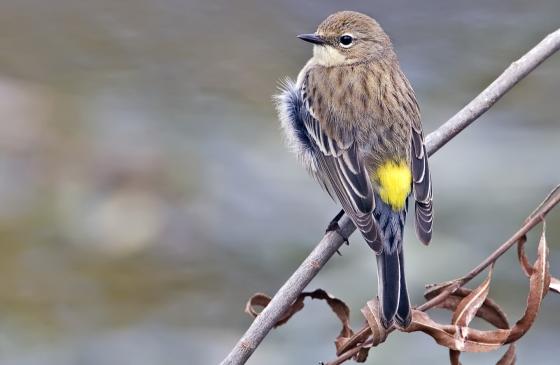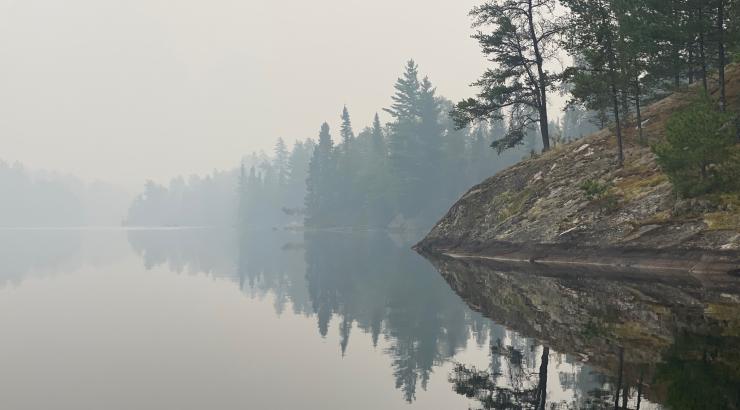Recently, we shared a Science Desk blog about landscape ecology, which considers broad patterns of ecological relationships and processes that can never be corralled by boundaries on a map. Its principles support the eagle-eyed perspective we need to protect the Boundary Waters. Water flowing into the Boundary Waters has a huge influence on wilderness water quality and everything that depends on it, so we think in terms of entire watersheds when we consider proposals to undertake sulfide-ore copper mining here.
Thanks to science reports we've commissioned and reports in the media, we know a lot about the flow of ground and surface waters within the Rainy River watershed. We can clearly see how contaminants could be transported from mining locations into the wilderness and beyond by Spruce and Stoney Creeks and associated flowages, the Kawishiwi and Rainy Rivers, and points west and north.
What happens within our airsheds also demands the broad perspectives of landscape ecologists and wilderness advocates. Vast rivers of birds flow across oceans and continents, following flyways that connect wintering grounds with distant breeding habitat – which for many is the Boundary Waters and surrounding wildlands. The air currents that carry these great migrations would be polluted by sulfide-ore copper mining as surely as the rivers beneath.
Sometimes we get an inkling of that airy river when we hear the soft twittering of birds flying in starlight all through the night. Radar that can track migrating birds and reveal the magnitude of the great migrations has helped create the concept of flyways as rivers. That metaphor was embedded in my mind by an encounter with warblers on a cool and misty day in mid May several years ago.
I was planting trees on a campsite on Alton Lake. Across the lake, the treetops, just beginning to leaf out, were vibrant green pillows scattered across the pale landscape. A few yellow-rumped warblers preyed on a hatch of soft little flies.
 By late morning the just-hatched insects covered every rock, tree, and shrub near the lake, and suddenly I realized there were warblers everywhere. Along the shore from the south came dozens, then hundreds, all on the prowl, plucking flies from every surface. There were gorgeous redstarts, strikingly handsome black-throated greens, bay-breasteds resplendent with velvety brown heads and rich chestnut throats. Rusty-cheeked Cape Mays searched a young fir beside me while palms worked the ground practically at my feet. By noon I’d seen more than half of the 24 species of wood warbler that nest in the BWCAW, and they were there by the thousands.
By late morning the just-hatched insects covered every rock, tree, and shrub near the lake, and suddenly I realized there were warblers everywhere. Along the shore from the south came dozens, then hundreds, all on the prowl, plucking flies from every surface. There were gorgeous redstarts, strikingly handsome black-throated greens, bay-breasteds resplendent with velvety brown heads and rich chestnut throats. Rusty-cheeked Cape Mays searched a young fir beside me while palms worked the ground practically at my feet. By noon I’d seen more than half of the 24 species of wood warbler that nest in the BWCAW, and they were there by the thousands.
They piled up against the shore where a bay blocked their flow, until the point was alive with beautiful warblers from forest floor to canopy. Then they surged out across the bay and flew northward, pushed on by warblers pouring in from the south.
I later found that friends at Tettagouche State Park and in Grand Marais, and my husband on Knife Lake were witness that day to the same spectacle, so the crest of this wave of warblers must have been at least 40 miles wide.
Bud Heinselman, in his classic book The Boundary Waters Ecosystem, reports astonishing numbers of warblers in the Boundary Waters and surrounding wildlands. His estimates, based on studies done in the 1970s–80s, range from 1,300–2,200 pairs per square mile - which adds up to some 5 million adults and young wilderness-hatched warblers at the start of the fall migration.

Every one of these warblers preys on insects. One pair can pick off all the caterpillars from a million leaves in the 10 days it takes them to fledge their young. Even though each warbler is tiny (most weigh well under an ounce) together they provide invaluable free (and pesticide-free) insect control services throughout their nesting habitat and on down the flyway. We know about many of the hugely beneficial ways warblers interact with their environment. For example, Tennessee, Cape May, bay-breasted, and blackburnian warblers play a big role in regulating frequency and severity of spruce budworm epidemics. Many others, no doubt, are yet to be discovered.
Chel Anderson and Heidi Fischer discuss the bird-forest relationship that is so crucial to forest health in their book North Shore: A Natural History of Minnesota’s Superior Coast. Summed up, our forests must have birds, including the all-important warblers, to maintain health and vigor; and for warblers, forests with a diversity of communities of different species and of various ages, including especially mature coniferous forests in unbroken tracts, are absolutely essential. When this relationship fails, results are dire.
 These wonderful warblers are in danger from Twin Metals and the other proposed mines. An obvious peril would be the displacement of thousands of birds by the mining operations’ footprints. Nesting habitat lost to new roads, buildings, parking lots, and waste disposal sites could not be replaced, and each year would mean the loss of what should have been that generation’s offspring.
These wonderful warblers are in danger from Twin Metals and the other proposed mines. An obvious peril would be the displacement of thousands of birds by the mining operations’ footprints. Nesting habitat lost to new roads, buildings, parking lots, and waste disposal sites could not be replaced, and each year would mean the loss of what should have been that generation’s offspring.
The operations’ footprints would be irregularly shaped, meaning that new forest fragmentation would be maximized. A study of global changes in forest cover from 2000 to 2012 reveals that we’re losing forest interior three times as fast as loss of overall forest. While there was a net loss of forest cover about 2 ½ times the size of Texas during that period, it’s the fragmentation that’s the bigger worry. The authors conclude, “Forest area loss alone from 2000 to 2012 underestimates ecological risks from forest fragmentation. In addition to the direct loss of forest, there was a widespread shift of the remaining global forest to a more fragmented condition.” This is bad because some organisms, including some songbirds, must have large stretches of unbroken forest.
Also, interior (unfragmented) forest can better withstand impacts from things like invasive species and various kinds of pollution. At the edges of forests, and in small fragments of forest – exactly what the mining operation has produced, with its hundreds of test drill sites with access roads widely scattered throughout the forest, and which would continue to be produced should operations proceed - things like variation in soil moisture, nighttime lights and noise, and traffic have a much bigger impact.
Along the edges of the mining operations, 24/7 noise and light pollution would be more than a nuisance to wildlife of many kinds. For example, even seemingly innocuous lights like porch lights and street lamps have been shown to have negative impacts on migrating and nesting songbirds. The dead zone as far as successful nesting for warblers might extend far beyond the actual footprint of mining operations.
The air the birds travel and breath would be contaminated with dust which could carry, to name some of the toxic ingredients, mercury, sulfur, copper, nickel, cobalt, arsenic, lead, and cadmium, as well as asbestos-like fibers and non-toxic, but still unhealthy, particulates. This scary mix wouldn’t just hover above the mine sites. It would become part of the currents of air that stream up toward Ely some days and out across the wilderness and on to the North Shore on others, to be breathed into lungs, scattered across leaves, lakes, soil, caterpillars, canoeists, warbler nests, and your garden and mine.
The University of Minnesota’s Center for Forest Ecology Director Lee Frelich discusses potential impacts likely to affect the Boundary Waters in his report Forest and Terrestrial Impacts of Mining. According to Dr. Frelich, windblown metallic dust can remain a problem for several decades after mining ceases on copper-nickel mine tailings. Once in the soil, the heavy metals can be taken up by plants and can be further distributed by forest fires. It can contribute to acidification that may lead to mineral deficiencies and slow plant growth. Essential mycorrhizal relationships may be disrupted. Cumulatively, the overall resiliency of the forest may be diminished.
 Two kinds of rivers, aerial and aquatic, intersected this morning in the form of a yellow- rumped warbler bugging above the Temperance River, not far from where it flows out of the Boundary Waters. He flew in on last night’s front, and now he’s hunting from the top of a young cedar. From his perspective and ours each insect is backlit by golden sunlight. He eyes his prey, darts out and does some fancy maneuvering, makes the catch and flits back to his perch. He throws back his head and sings.
Two kinds of rivers, aerial and aquatic, intersected this morning in the form of a yellow- rumped warbler bugging above the Temperance River, not far from where it flows out of the Boundary Waters. He flew in on last night’s front, and now he’s hunting from the top of a young cedar. From his perspective and ours each insect is backlit by golden sunlight. He eyes his prey, darts out and does some fancy maneuvering, makes the catch and flits back to his perch. He throws back his head and sings.
This bird has traveled to habitat that’s uniquely perfect for his springtime needs. No other place in his entire range has habitat this intact, air and water this free of pollution, insects this abundant. I really wish I could tell him that his kind will always be able to come here and find clean air to fly through and clean water to hunt over.
We’re still in the early days of spring with not much happening in the woods, color-wise, so the bright yellow splashes on his rump and sides are eye-catching in a way you could say are out of proportion to their tiny size.
You might say, too, that our delight in watching one little bird is a little over the top, but I don’t think so – it feels just right, in this beautiful place, to pause and admire a perfect little predator just returned to the northwoods after an epic journey.
Ellen Hawkins lives near the edge of the Boundary Waters, off the Sawbill Trail. Retired from the Forest Service, she finds that surprise encounters with wildlife of all kinds are still among her most delightful experiences, just as they were during her years as a Wilderness ranger.
Citations
Anderson, Chel; Fischer, Adelheid. 2015. North Shore: A Natural History of Minnesota’s Superior Coast. The University of Minnesota Press, Minneapolis, Minnesota.
Frelich, Lee. 2014. Forest and terrestrial ecosystem impacts of mining.
Heinselman, Miron. 1996. The Boundary Waters Wilderness Ecosystem. The University of Minnesota Press, Minneapolis, Minnesota.
Riitters, Kurt; Wickham, James; Costanza, Jennifer K.; Vogt, Peter. 2015. A global evaluation of forest interior area dynamics using tree cover data from 2000 to 2012.


